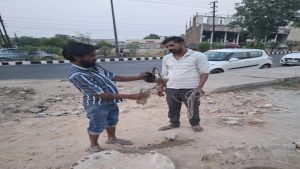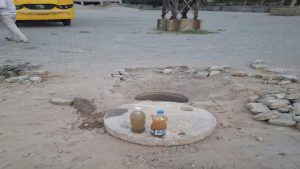Chemical Assault: Industries Dump Waste into Buddha Darya
BY : PR NETWORK
Ludhiana, Punjab: An exclusive investigation has revealed a shocking case of environmental sabotage in Ludhiana, where industries are exploiting an abandoned stormwater pipeline to discharge untreated industrial effluents into Buddha Darya. The pipeline, damaged during the Chandigarh Road expansion project, has been criminally misused by industrial units in the Focal Point area and others along the Chandigarh stretch.
Widespread Misuse of the Pipeline
 The abandoned stormwater pipeline has been found to be interlinked with multiple sewage lines, including those meant for the 225 MLD STP. This has resulted in the catastrophic mingling of stormwater and industrial sewage, causing irreversible environmental damage. Several pipelines servicing dyeing clusters, especially those connected to the Tajpur CETP, have been illegally rerouted to discharge into both the abandoned stormwater and legal sewage networks.
The abandoned stormwater pipeline has been found to be interlinked with multiple sewage lines, including those meant for the 225 MLD STP. This has resulted in the catastrophic mingling of stormwater and industrial sewage, causing irreversible environmental damage. Several pipelines servicing dyeing clusters, especially those connected to the Tajpur CETP, have been illegally rerouted to discharge into both the abandoned stormwater and legal sewage networks.
Environmental & Health Impact
 The toxic discharges have contaminated soil and groundwater, posing a direct threat to public health, aquatic life, and the fragile ecology of Buddha Darya and the Satluj River. Blackish and reddish foul-smelling water was observed near Bhamian Road Crossing and area closer to Buddha Darya, respectively.
The toxic discharges have contaminated soil and groundwater, posing a direct threat to public health, aquatic life, and the fragile ecology of Buddha Darya and the Satluj River. Blackish and reddish foul-smelling water was observed near Bhamian Road Crossing and area closer to Buddha Darya, respectively.
Institutional Complicity & Governance Failure
The investigation has revealed jurisdictional loopholes, deliberate negligence, and collusion between MCL staff and industrial units. The Municipal Corporation of Ludhiana (MCL) relies heavily on temporary staff with minimal accountability, low pay, and alarming susceptibility to influence from industrial offenders.
Immediate Enforcement
 To address the environmental crisis, immediate action is necessary. The abandoned stormwater pipeline should be sealed and dismantled, and a criminal investigation should be launched into the illegal connections and discharge points. Defaulting industries should be blacklisted and closed, and public disclosure of offenders should be made to ensure transparency and deterrence. Additionally, compensation and remediation plans should be implemented for affected farmland and water bodies, and accountability action should be taken against supervisory staff who failed to report or prevent this environmental crime.
To address the environmental crisis, immediate action is necessary. The abandoned stormwater pipeline should be sealed and dismantled, and a criminal investigation should be launched into the illegal connections and discharge points. Defaulting industries should be blacklisted and closed, and public disclosure of offenders should be made to ensure transparency and deterrence. Additionally, compensation and remediation plans should be implemented for affected farmland and water bodies, and accountability action should be taken against supervisory staff who failed to report or prevent this environmental crime.
This is not merely a case of environmental violation — it is a deliberate, systemic sabotage of public health and natural heritage. Immediate and exemplary action is demanded to prevent further environmental damage and hold the perpetrators accountable.








